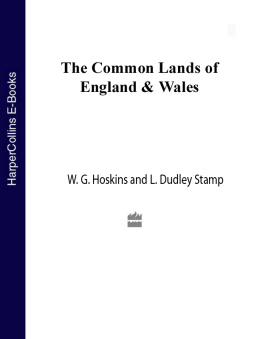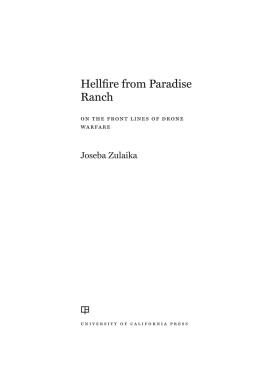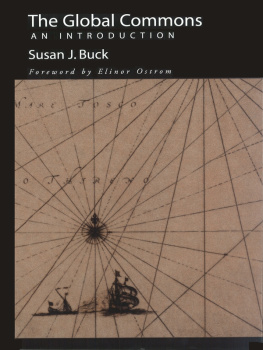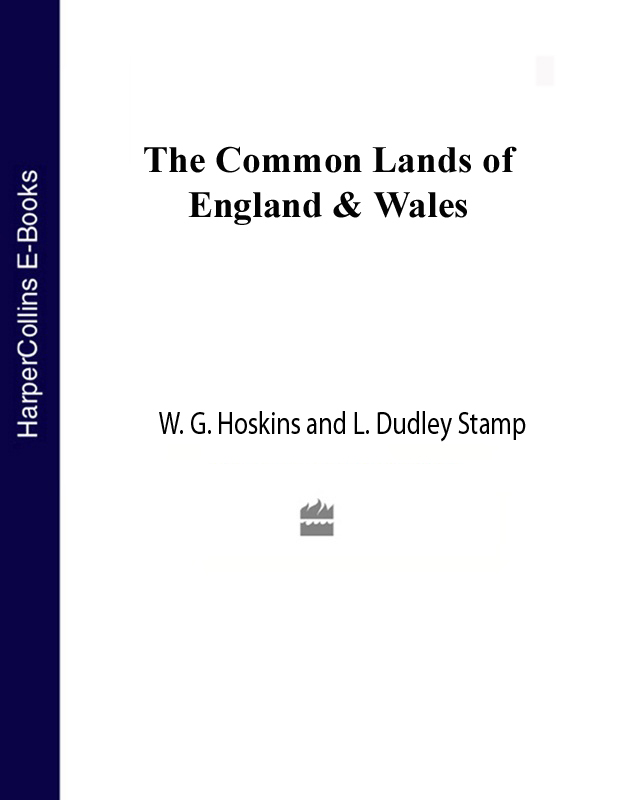CONTENTS
EDITORS
James Fisher, M.A.
John Gilmour, M.A., V.M.H.
Sir Julian Huxley, M.A., D.SC, F.R.S.
L. Dudley Stamp, G.B.E., D.LIT., D.SC.
PHOTOGRAPHIC EDITOR
Eric Hosking, F.R.P.S.
The aim of this series is to interest the general reader in the wild life of Britain by recapturing the inquiring spirit of the old naturalists. The Editors believe that the natural pride of the British public in the native fauna and flora, to which must be added concern for their conservation, is best fostered by maintaining a high standard of accuracy combined with clarity of exposition in presenting the results of modern scientific research.
William Collins
An imprint of HarperCollinsPublishers
1 London Bridge Street
London SE1 9GF
WilliamCollinsBooks.com
This eBook edition published by William Collins in 2018
First published 1963
W. G. Hoskins and L. Dudley Stamp, 1963
The authors assert their moral rights to be identified as the authors of this work
A catalogue record for this book is available from the British Library.
All rights reserved under International and Pan-American Copyright Conventions. By payment of the required fees, you have been granted the non-exclusive, non-transferable right to access and read the text of this eBook on-screen. No part of this text may be reproduced, transmitted, downloaded, decompiled, reverse engineered, or stored in or introduced into any information storage and retrieval system, in any form or by any means, whether electronic or mechanical, now known or hereinafter invented, without the express written permission of HarperCollins Publishers.
HarperCollinsPublishers has made every reasonable effort to ensure that any picture content and written content in this ebook has been included or removed in accordance with the contractual and technological constraints in operation at the time of publication.
Source ISBN 9780007342228
Ebook Edition NOVEMBER 2018 ISBN: 9780007403639
Version: 2018-11-23
The Editors take particular pleasure in presenting this volume in the New Naturalist series because they believe it is a book to which the word unique may be justly applied for several reasons.
It is surely an anomaly that in a crowded country such as England and Wales with 46,000,000 people living on 37,000,000 acres there should still be four per cent of the surfaceas much as occupied by the dwellings of urban manheld in common and governed by a miscellaneous collection of laws dating back in many cases for centuries. Pressure on land has become such that we can no longer afford to neglect this national heritage. What in the past was often waste left to lie idle because of its low agricultural value has become to-day a precious reservoir of wild life, but continued neglect can ruin its value in that regard as much as in any other.
Despite the obvious need, successive governments for long hesitated to set up a Royal Commission on Common Land, fearing unpredictable political consequences with such easily raised but ill-informed cries as hands off the commons. After its appointment had been definitely mooted for at least two decades, it was set up in 1955 under the chairmanship of an experienced lawyer, Sir Ivor Jennings. A fundamental part in the work of the Commission and the writing of the Report fell to its able secretary, Mr. George L. Wilde, and the two authors of the present volume wish to express their great indebtedness to Mr. Wilde for helping them in the interpretation of the vast mass of material collected by the Commission.
As the expert historian and geographer respectively on the Commission, Dr. Hoskins and Dr. Stamp each wrote a lengthy appendix to the Report from their respective angles: now they present for the general reader an account uninhibited by the insistent need for circumspection inherent in membership of a Royal Commission.
It is one thing to write in general terms about commons, quite another to gather together what is actually known about them. For the first time ever the Royal Commission called for details from the counties. It has been left to the authors to summarize these county returns one by one and to attempt, however unsuccessfully, to give a list of known or suspected commons. They have gone further and, again for the first time, have attempted a list of village greensan associated heritage so essentially part of the rural scene.
We believe that this book will inform the public at a time when far-reaching legislation is pending and will stimulate local interest everywhereif only to tell the authors where they are wrong.
THE EDITORS
There are still one and a half million acres of common land in England and Wales, which give us some of our most distinctive scenery, flora, fauna, and above all perhaps bird life. Regions such as the New Forest, the Forest of Dean, Dartmoor, the Brecon Beacons, and many other well-known holiday districts, to this day consist largely of common land. Yet there is no book which deals with this unique aspect of the English and Welsh landscape as such, and there exist many popular misconceptions about the meaning of common land and of the rights of the public over it.
Though common pastures were one of the most fundamental necessities of the old peasant economy which once prevailed all over Britain, without which the whole economy would have broken down very quickly, one rarely finds any reference to Commons and Common Rights in the index of even the most erudite social and economic histories. Too often commons have been regarded, even by the most learned authors, as virtually synonymous with uncultivated wilderness and waste, of little or no economic value. Nothing could be further from the truth historically.
We have written this book after serving for three years on the Royal Commission on Common Land (19558), because we felt that such a comprehensive study in non-official language was badly needed. One of us is an historian, the other a geographer. It is important to emphasize that any views that may be expressed in our respective chapters are our views as individual writers, and not as members of the Royal Commission whose Report has yet to be considered by Parliament.
Part I of the book traces the history of common lands in England and Wales from their shadowy beginnings as prehistoric grazing-grounds down to the present day, showing how vital they were in the old agrarian economy by which the vast majority of people once lived, how they reached their present form and status, and how the law relating to these lands has reached its present complexity. It also serves to dispose, it is hoped, of certain myths about the nature of common land, such as the belief that it is public property and that the public have unlimited rights of access to what they regard as their own.
Part II deals with the present distribution and nature of common lands in England and Wales, region by region, with particular reference to the larger and more important commons but not forgetting the humble village greens. It should perhaps be explained at this point that because of the accident of history Scotland has no common land as we understand it in England and Wales, and it is therefore not considered at all in this volume.
The concept, if not the definition, of common land is clear enough, but the subject has often been confused in the minds of ordinary readers by the indefensible use of common fields for what are better called simply open fields. After harvest the open fields were customarily thrown open to the animals of the villages for grazing upon the stubble until the time (usually about Candlemas) for the new crop to go in. Hence the open fields were sometimes known as commonable lands because rights of common pasture could be exercised over them for certain limited periods. They were also known widely as Lammas lands, because they were usually thrown open for common grazing round about Lammas Day (August 1st). In this book we are not concerned at all with these open arable fields and the limited common grazing they permitted, but only with common lands in the fuller sense of the term, grazing land over which common rights were, or could be, exercised all the year round. We have, however, taken note of those Lammas lands where stock were excluded for certain periods to permit recovery of the grazing.









